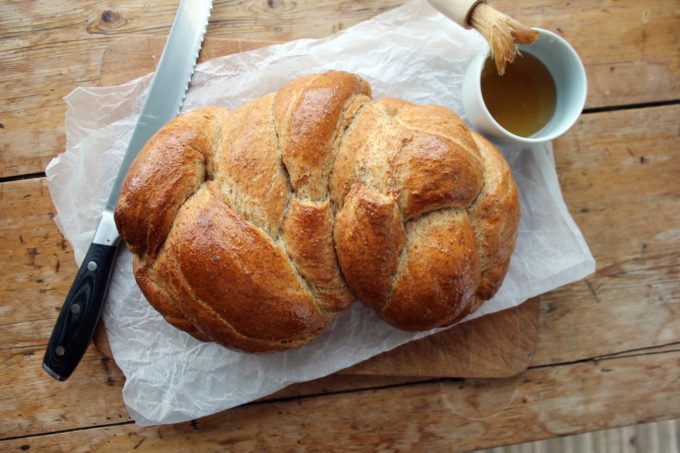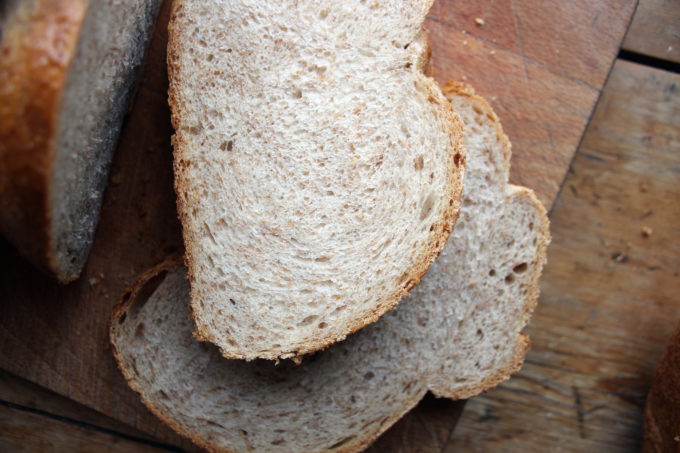
As regular readers will know, I love baking bread. It’s such a visceral thing. From the simple act of choosing the flour and weighing out the ingredients to the more tactile process of kneading the dough. (Although quite honestly I’ve been using my glorious smeg stand mixer with a dough hook to knead my bread for the past few years which makes the whole thing so incredibly easy,) it’s almost like a spiritual practice. It’s about finding a rhythm with the reward of the incredible aroma of freshly baked bread wafting through your home and of course, a wonderful loaf at the end.
Over the years i’ve tried pretty much all the different baking trends that have come along, from the basic and most traditional through to the low-knead method (with failures and successes at all) and am now into a method which I believe is called cast-iron baking. It’s pretty much as uncomplicated as it sounds. Instead of baking your dough in a traditional loaf tin or free-form on a baking tray you use a cast-iron casserole dish, with a lid to bake. I’m not fully versed on the exact science behind why it works so well (and if i’m honest I started using my small Le Creuset casserole as a baking vessel over a year ago when I damaged my regular loaf tin) but works well it does. I guess it has something to do with the way the cast iron heats up so that it’s almost as though you’re creating a mini-oven inside your regular oven, in the same way that a tandoori or chicken brick works so well.
I have two cast-iron pots that I use for different loaves. I use a 19cm diameter x 9cm deep round casserole pot for my regular everyday loaf which uses 500g of flour which I have the lid off during the whole baking process and then I also use a 30cm x 24cm x 11cm deep oval casserole pot for a larger loaf which uses 750g flour which I will leave the lid on the pot for part of the baking. Plus, the pot goes into the oven from cold so it’s second rise happens slowly in the oven. Don’t know why it works but it does, with amazing results.
For more inspiration on baking bread in a cast iron skillet check out Rosie over on instagram who has some very successful examples as well as Karen over at Lavender and Lovage does it with her sourdough.

these loaves were all baked using the cast-iron baking method – the two on the left using my small round casserole dish with this recipe and the one on the right in my large oval casserole dish using 750g flour.
honey and wholemeal plaited loaf
This is a delicious and earthy loaf that works very well with the cast-iron baking method. Wholemeal bread can be quite chewy and a little ‘hardy’ so the honey (and a little milk) helps soften and sweeten it up. I chose to plait the loaf just to do something different but it could work just as well in one large ball of dough.
- 500g strong white bread flour
- 250g wholemeal flour
- 1 and a half sachets of easy bake yeast (10.5g)
- one and half teaspoons salt
- 1 tablespoon olive oil
- 1 tablespoon runny honey
- roughly 600ml liquid (made with 500ml water and 100ml milk)
Place all the dry ingredients into a large bowl (or the bowl of your stand mixer) add the honey and the oil and then slowly add the liquid as you begin the stir the ingredients together. (This can be done with your hand in a claw shape slowly rotating around the bowl, or with a dough hook on a low speed.
Once all the ingredients come together and a dough begins to form you can begin the real reading process. You want a medium wet dough, not too sloppy but not too dry but it’s really hard to tell in a written recipe, you just have to have a feel for it. Sometimes you’ll use all 600ml of liquid and sometimes you won’t need as much which is why I advise to add it gradually and bring the dough together slowly.
Now either tip the dough onto a lightly floured surface for kneading of turn the speed up on the dough hook and knead for 10 mins. The dough should become light and smoother and springy to touch
Place it in a well-oiled large bowl, cover tightly with clingfilm and set aside for at least an hour on until the dough has doubled in size
Grease your casserole dish well with olive oil and turn on your oven to 220C
Tip your dough onto an oiled surface and punch it hard, fold it in half, punch it again and turn, then do this again. Now divide the dough into three equal portions and roll them out into long fat sausages
Plait your dough into an even plaited loaf. It’s your basic three-strand plait so it’s pretty basic but feel free to youtube it if you don’t feel confident. One tip is that I always plait bread from the middle rather than one end. It makes for a more even bread.
Once the dough is plaited, tuck the ends under and lift it swiftly into your casserole dish, place the lid on and slip it into the oven for 40 mins with the lid and then a further 20 mins without the lid.
Once baked very carefully remove the casserole pot from the oven and tip out the bread onto a wire rack to cool completely before eating

eat and of course, enjoy!







Lovely looking loaf and a masterclass in bread making. Xx